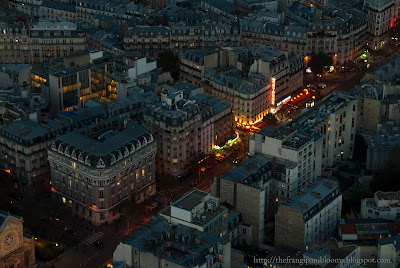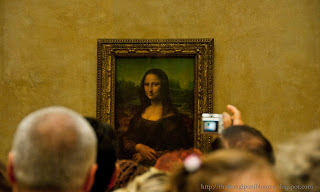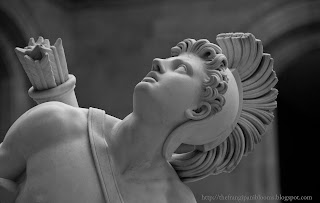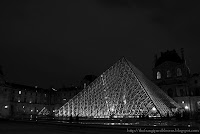I think fluorescent tube-lights cast a very unflattering
white light. Add to that a clattering metro train with an ageing steel chassis, worn purple seats and damp grey platforms outside the grimy windows and
you definitely don’t have the most cheerful of atmospheres. The crowd is a mix
of black and white people, with a stray brown bloke like me thrown in. This
could easily be New York’s gloomy subway. It’s even got the same garish
fluorescent graffiti on platform walls and tunnels.
 |
| Arguably the most famous iron structure in the world |
I was riding in to Paris on the metro from the Charles De Gaulle Airport to my brother’s apartment. Over the next nine days, I would get up close and personal with the arts, architecture, language, people and food of this city and repeatedly confirm what I had realized on that first day- Paris is like no other city in the world. And that is so because Parisians want it to be so.
 |
| Arc de Triomphe |
 |
| Evening settles over Paris, seen from the Montparnasse |
are 4 storeys of ornate stone facades with the top windows jutting out of sloping roofs, while the bottom levels are occupied by beautiful cafes and shops. Even a simple pharmacie in Paris can have art deco lettering and a 1920’s shop-front. Parisians have stubbornly refused to allow any new construction within the confines of their old city. The top of the new Montparnasse tower built in the early 70s is snidely called the best spot in Paris, because it is the only place in the city from where you cannot see the skyscraper. This heritage tag attached to every brick and paving stone has strangled the supply of new homes within the city limits. As a result, many Parisians just end up renting a house and never buying one all their lives. Even the portable green ‘box’ book shops on the banks of the Seine (‘the only river that runs between two bookshelves’) are coveted property. A tradition harking back to the 16th century, new licenses for these bookshops are no longer being issued and existing ones are handed down like family heirlooms.
 |
| The sun after the rain |
 |
| A Parisian street leading to The Luxembourg Gardens |
 |
| Les Invalides after a squall of rain |
 |
| The gardens of Les Invalides |
Of course we hopped off at every major monument for a closer look. But we also saw much of the city from the upper deck, as we rode past leafy boulevards littered with autumn leaves and windows with roses blooming on the sills, past chiropracteurs and boulangeries, and marchés and bureax de poste, and fleuristes and brasseries, across narrow cobblestone streets and wide bridges over the Seine. The city is an incredible portrait of the 18th century urban aesthetics of Europe.
“Parisians seem to spend an inordinate amount of time on appearances”, my brother had quipped when I had first asked him about his impressions of the city. Well, the city does it too, and in grand period style.
 |
| A bright autumn day in Paris |
_________________________________________________________________________________
1. Salons: 17th and 18th century literary gatherings to exchange and appreciate each others’ work
Of Dinners and Museums
Fine dining is a concept that
Paris has given to the world, among other things. Even as a kid, I remember my
characters in Enid Blytons and PG Wodehouses drool over French cuisine. Wodehouse’s celebrated French chef, anatole, has always been a key bargaining
chip in negotiations to extricate Bertie Wooster from the soup
he usually finds himself in.
 |
| Coffees and Conversations from the city that gave the world the Café |
 |
| The Sacré-Cœur Basilica at Montmartre |
Dining out is serious business in Paris and has been so for far longer than any other place in the world. You could choose to eat in a Café,
a Bistro, a Brasserie, or a Crêperie3. The food is delectable and expensive-a meal in
Paris with wine can cost anywhere upwards of 20 Euros per person. The confit de canard (duck), the chèvre (goat cheese) pastas, the moules-frites (mussels and fries), the Crème brûlées and the vins
(wines) that I had at various times on this trip were absolutely delightful, my
preference for vegetarian food notwithstanding. But dining in Paris is as much
about the company as it is about food. You catch up with old friends and even
meet new ones over long leisurely dinners. One dinner I had lasted for 2.5
hours. No plates were cleared until the last person on the table had finished
eating and no check was produced until we asked.
 |
| Paris lights up at dusk |
The notorious French working culture was inevitably the
topic of conversation that night. ‘Is it really like that?’ we asked our French
friend we met over dinner that night, after discussing a few horror stories about
how the French (don’t) work. He smiled. “It’s always a bit exaggerated. A 60
hour work week for people like us is not uncommon at all. Nowadays it might
only be the lower ranking staff like bank tellers who can pack up and leave at 5
everyday. Anyone who holds a position of responsibility and has the ambition to
build a career had better think twice about how he works”. A
highly educated fresh graduate, perhaps he represented a changing face of the
French workforce (one that spoke English very well). And he never spoke a truer
word. With two rating agencies stripping France of its AAA rating and a
not-so-veiled threat to do likewise from the third4, the France is going to
have to pull together its game, and soon. One misstep and it may find itself on
the path to join its Mediterranean neighbors in the south. But change is slow. Some things will be hard
to let go of, and I can very well imagine why.
A passing mention of his 50 ruddy days of vacation a year was enough to
leave us green with envy.
 |
| The glittering city seen from Montmartre |
“I feel so nice when someone makes the effort to learn and
speak French. We’re rather proud of our language, and appreciate it when
someone takes notice of it”, he said, steering the conversation to calmer
waters and echoing the sentiments of many other French men and women I met
through the trip. A little ‘Bon Jour’
and ‘Excusé Moi’ and ‘Merci’ can change the tone of a conversation. French is indeed a very
beautiful language. Other merits of a language apart, it sounds incredibly
musical to the ears, far more so than English or any other language I know. You
only have to hear a French song
like La Vie En Rose to realize that the language was built for music, with its nasal
‘ain’s, the curvy ‘oi’s, the sensual ‘j’s ‘ and the very French ‘u’s
(made by pronouncing an ‘ee’ but puckering your lips as if to kiss). Even the
soft throaty ‘r’s manage to join in the harmony. German on the other hand sounds
like chain saws, and many Indian languages, like rattling trains.
 |
| The Mona Lisa holds court at the Louvre |
 |
| A medieval German bust of Christ |
That very satisfying dinner had come on the heels of a very
rainy afternoon well-spent at the Louvre. I doubt if any other museum in the
world is so famous, and has so many visitors who couldn't care less about
history and art. I know people who
would prefer water-boarding at Guantanamo to visiting museums. And yet they all have visited the Louvre. Their
recollections of the place usually consist of statistics like the 10 miles they walked inside the museum in a single day, and the 20 minutes within which they managed to ‘cover the whole of Renaissance and Ancient Egypt’.
Well, I decided to spend 20 minutes at the entrance with a map instead, and concluded that I only wanted to see the Dutch and Italian paintings, the Marble
Sculptures and Napoleon III’s apartment. And to start with, I made a beeline for the Mona Lisa.
 |
| The Marble Warrior |
At the end of the
day, I walked very few miles at the Louvre, but had more than enough time to marvel at the
lush works of art that stood arrayed before me.
These masters have shown that heroism, pathos, love, pain, all can be
carved out of stone and frozen on to a canvas. It must have taken a detailed
study of human anatomy, years of practicing their workmanship, and finally, a
heart to feel everything that you wanted your viewer to feel. The Dutch
landscapes, for instance, have
the power to stop you in your tracks. They take you straight to the hills and rivers and
woods of the European countryside, under the open skies.
 |
| The Louvre |
 |
| Autumn sunshine at the Luxembourg Gardens |
3. Café : a restaurant primarily serving coffee as well as pastries and light meals such as sandwiches
Brasserie: A type of French restaurant with a relaxed, upscale setting, which serves single dishes and other meals. A brasserie can be expected to have professional service, printed menus, and, traditionally, white linen —unlike a bistro which may have none of these. Typically, a brasserie is open every day of the week and serves the same menu all day
Bistro: a small restaurant serving moderately priced simple meals in a modest setting. Bistros are defined mostly by the foods they serve. French home-style cooking with robust earthy dishes, and slow-cooked foods like cassoulet, a bean stew, are typical
Crêperie: a takeaway restaurant or stall, serving crêpes as a form of fast food or street food, or may be a more formal sit-down restaurant.
4.Standard and Poors and Moodys have downgraded France's sovereign debt rating from AAA and Aaa to AA+ and Aa1 respectively in 2012 while Fitch has a negative outlook with its AAA rating



No comments:
Post a Comment